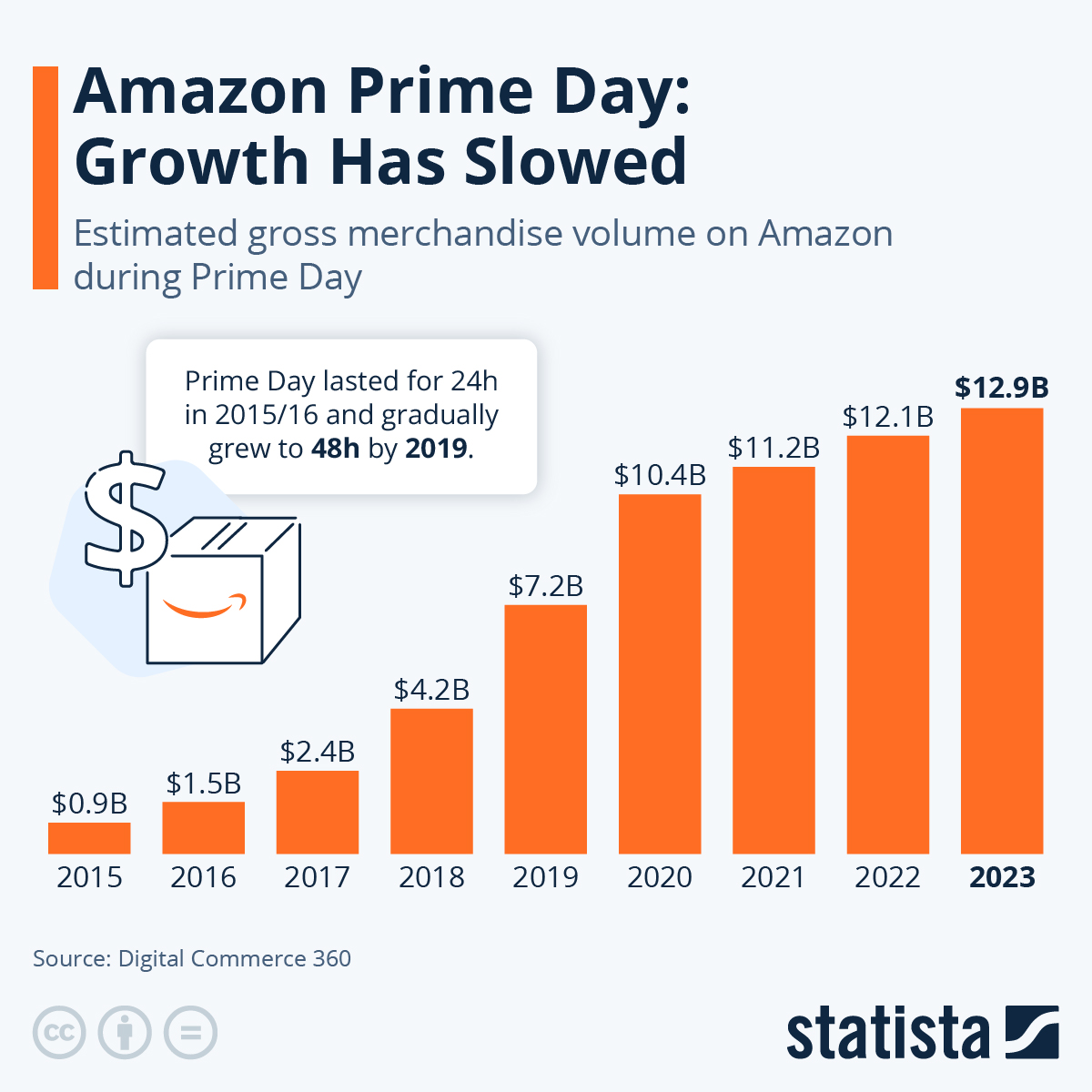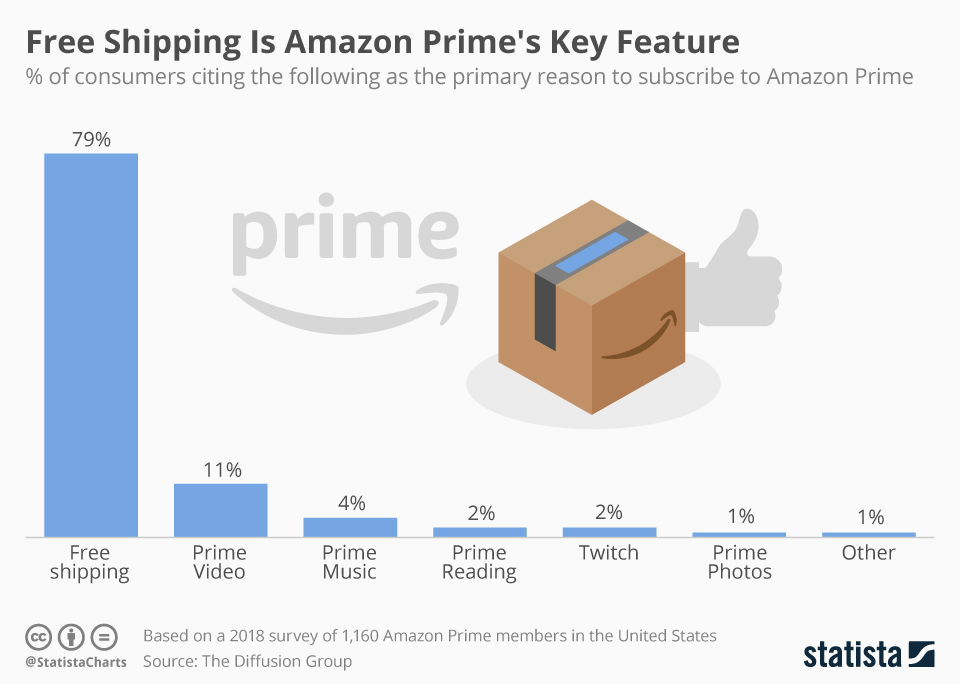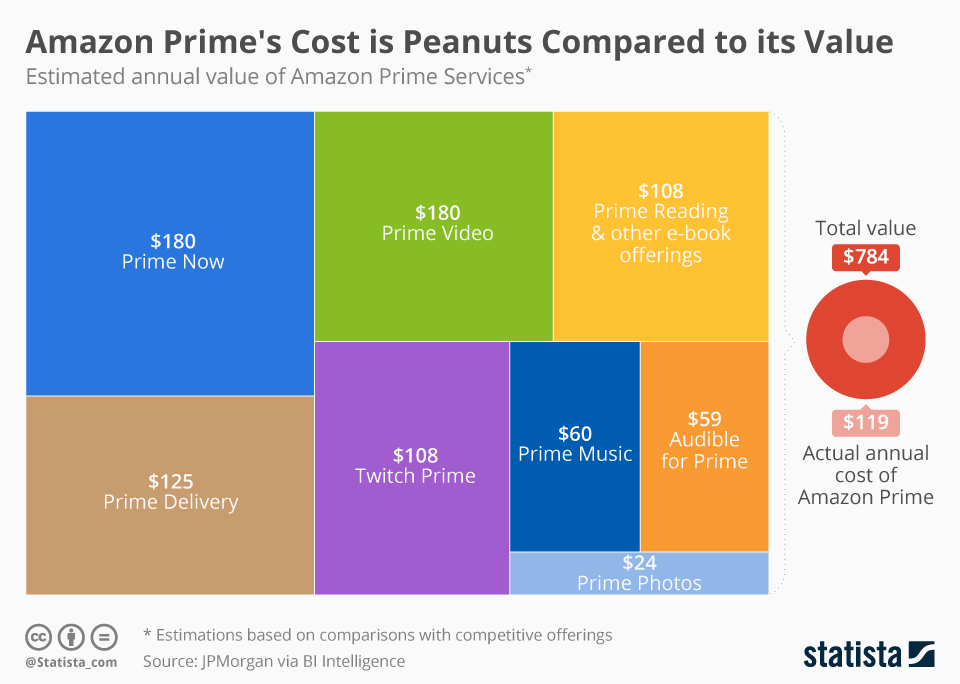“All-Inclusive” business model of Amazon Prime
Listen to the Story
‘Amazon Prime’ has now become a household name. Every home that I know of has at least one Prime membership. We’ve all used a relative’s or a friend’s Prime membership to get something delivered within two days of placing an order. That’s the kind of hold Amazon Prime has had on our lives in the past decade, showing us how much we value convenience and ease as human beings.
Amazon Prime has become the largest and most lucrative subscription model on Earth, consisting of Free Shipping (same-day, 2-day, or 2hour delivery), Prime Video, Prime Reading, Prime Music, Gaming, attractive discounts & the list goes on. It’s a one-way ticket to access all the perks Amazon has to offer with the largest selection of products and services. Amazon Prime has designed such a business model that it covers the entire gamut of services its users use in their daily lives.
With 200 Million Prime members across 20 countries, 148Million are present in its home country alone (USA) and still expanding globally. This is the impact Amazon has made with its subscription service ever since it was launched in 2005, only offering a free 2-day shipping service back then.
But the core idea of the Amazon Prime business model began in 2002, known as FastTrack – to speed up order processing and reduce shipment time. FastTrack is a key performance metric for vendors that measures the percent of customers that see an item as Prime Eligible.
This metric is used by third-party sellers who take up 56% of Amazon’s marketplace when they sell their products on Amazon taking into account an item’s in-stock rate and conditions in which an item arrives at Amazon’s fulfillment center. The higher a seller’s fast-track rate, the more number of items are seen as Prime Eligible.
FYI: In 2020, the e-commerce giant generated approximately 80.5 billion dollars in third-party seller services, an increase of nearly 50 percent over the previous year.
Jeff Bezos (the richest man currently exploring outer space) has always been a visionary. He didn’t want Amazon Prime to be just any other subscription service. He wanted to design Amazon Prime’s business model in such a way that it becomes a critical way of “locking” in customers into Amazon’s ecosystem of products and services.
Various stakeholders were nervous about implementing the Amazon Prime business model, as Shipping Revenue was a part of the profit margin when goods were sold. But Jeff was well aware of the short-term losses. He didn’t seem surprised and asked the team to stay firm on their plans. He had calculated Prime Subscription’s long-term success instead of focusing on the ‘quarter-by-quarter game.’ As mentioned in his open letter to the world:

Jeff’s vision turned out to be accurate. Prime Members end up spending more than double compared to non-members on an annual basis. This also gives Amazon a chance to analyze predictable revenue streams from each Prime member by tracking their behavioral and shopping patterns. In 2018, the company earned an estimated $232 billion in retail commerce. And it’s all thanks to its customer base. The average Amazon customer spends about $600 a year on the site. And Prime members? They spend $1,400 each. 133% higher. Wow!!
#JeffBezos has turned every cost centre into a revenue center.
He grabbed the opportunity at the right time by analysing own business. #Amazon #Business pic.twitter.com/BfcfFmDeah— Akshay Munot (@AkshayMunot_) August 19, 2020
Amazon announced its final quarter results of 2020, stating that Net Sales were $89Billion during the pandemic. Out of which its sales of all subscription services, including Amazon Prime-related membership fees, digital video, audiobooks, e-books, and other subscription services was $25.21 billion in 2020 (excluding AWS).
Mục Lục
Prime Day Sale
To commemorate the Amazon website’s 20th Birthday, Prime Day was launched in 2015, an annual event only for prime members wherein heavy discounts was applied on all products & services. It was the new “Black Friday Sale.” More than 250 million items were purchased during this 48-hour event in 2021 amid a pandemic, and sales for Prime day sky-rocketed to $11.19 Billion this year.
Gamut of Services in the business model of Amazon Prime
Prime Video
 You will find more infographics at Statista
You will find more infographics at Statista
The video streaming service hosts many movies and TV shows, including exclusive networks like HBO, CBS All Access, and Amazon’s own Prime Originals. Amazon owns the IMDB database, offering access to cast information, trivia, and behind-the-scenes stories.
Amazon’s recent acquisition of Metro Goldwyn Mayer (MGM) for a blinding $8.5Billion, would just let Amazon make as many James Bond sequels as it likes with access to MGM’s intellectual property, not forgetting a century’s worth of classic movies and TV shows. Prime Video is known to be the second most popular reason for subscribing to Prime Membership.
Prime Music
 You will find more infographics at Statista
You will find more infographics at Statista
The music streaming service is stocked with more than 2000 playlists/stations and 2 million songs. So-called ‘Amazon Music Experts create these playlists.’
Amazon’s Choice & Free Shipping
The eye-catching label – Amazon’s Choice is applicable on products valued for money spent based on– high ratings, a low return rate, competitive prices, and frequently bought by customers. The search for a sofa can lead to thousands of options leading to confusion.
Amazon’s Choice makes shopping for your off to college checklist easy! Check out our Electronics Gift Guide here: https://t.co/m9KBMidPOu pic.twitter.com/OYV12KjVeP
— Amazon (@amazon) August 19, 2017
This helps Prime customers save time from going through the same product offered by hundreds of sellers with differing qualities and prices. Amazon’s Choice is exclusively available for Prime Members only.
Free shipping was the core service offered during Prime’s inception, and it continues to be an integral part of Prime.
Prime Reading
A library including best-sellers, magazines, comics, and popular reads from trustworthy publishing houses, which can be borrowed for free with Audible narration. All titles for readers are hand-picked by editors.
JUST LAUNCHED: Prime Reading! Read as much as you want from hundreds of eligible eBooks, comics and more (T&Cs Apply.) Learn More: https://t.co/fnDxXeWg83 #PrimeReading #ReadAnytimeAnywhere #AmazonKindle pic.twitter.com/8NJIneM8H6
— Amazon Kindle India (@KindleIndia) September 25, 2018
Prime Gaming
It gives access to tons of exclusive video games with “free forever” games to select each month. It used to be called Twitch Prime (before Amazon acquired Twitch for US$970 million in an all-cash deal).
Combining all these attractive content services with something as simple as free shipping and easy returns has posed an unfair advantage against competitors.
Fred Wilson of Union Square Ventures recently expressed concerns for the same:
I worry Amazon has an almost unfair advantage in the content business because of Prime. It’s the craziest thing ever. Who would have ever thought shipping physical products to people at a loss would become this incredible competitive moat in the television business? Who dreamt that up? I happen to believe that it’s an accident that Bezos woke up one day and said, ‘Wow, actually we can take Prime, and we can use that revenue to subsidize our way into the content business.’ But honestly, if you’re a Prime subscriber, it doesn’t cost you any more to get their TV. And I have to come out of pocket with Netflix. If you’re only going to have one, which one are you going to have? People who don’t have hundreds of dollars a month to spend on entertainment might choose just one [entertainment provider], and Amazon might be the one they choose because they’re already Prime. They have to buy their groceries anyway. It’s just this incredible bundle.
The other side of the spectrum: Prime for Sellers
 You will find more infographics at Statista
You will find more infographics at Statista
Little does everyone know that a subscription service exists not just for Shoppers but also for first/third-party Sellers and Business Owners. They promote their products on the platform – Amazon Business Prime.
Business Prime is here! Our annual membership program offers Amazon Business customers new benefits that help simplify the procurement experience. Find out more at: https://t.co/TkgTUW5YcD pic.twitter.com/NG0HDAlC2B
— Amazon Business (@AmazonBusiness) October 24, 2018
This particular subscription service has a different set of perks and is “strictly business,” so much so that it doesn’t include Prime Video membership. The perks offered are:
- creating logins for business employees
- Opening an Amazon Corporate Credit Line
- Amazon WorkDocs to collaborate on invoices, receipts, etc.
- Free Business Analytical tool for owners to track product spends, monitor sales, etc.
- Creating approval procedures & applying spending caps for purchases.
- Small businesses can apply & qualify for Tax Exemptions.
- Use Fulfillment by Amazon (FBA) to ship products to an Amazon fulfillment center/warehouse and letting Amazon take care of the storage, packing, shipping, returns, refunds, and customer service for you. Now that’s fulfilling.
This proved to be a win-win situation for both parties easing business owners’ responsibilities and providing seamless delivery of products by Amazon Prime. Some sellers built their business from scratch just by selling their products on Amazon, and now there are hundreds of YouTube tutorials on how to become a successful Amazon seller. Thanks to FBA.
The registration process for Business Prime is strict. It verifies the business’s credentials and history before offering the subscription by asking for the business address, email, and Tax ID. Amazon also partners with Forrester Consulting to analyze the potential ROI for the business if it is offered a subscription. The subscription cost for a business ranges from $69/user to $10,099 for unlimited users per year.

Competition
There are various other retailers, both small and large, which offer subscription services to customers. Amazon competes with these retailers head-to-head for market share but has successfully captured most of it in recent years. Some of the rivals are Target, Walmart, Costco & BestBuy when it comes to retail stores. The rivals in the subscription services field are Alibaba (AliExpress), Flipkart, Netflix, Apple, and Google.
When third-party vendors promote & sell their products on the Amazon platform, vendors pay a commission fee and other related fulfillment costs, contributing to sales and profit. Jeff Bezos has stated that their main competitor is eBay when it comes to subsequent party sellers.
Given the rise of the middle-class sector in India and increased spending, it has become one of the most significant growth markets. Amazon was launched in India in 2016 and has been exceptionally successfully competing with the other local giants like Flipkart and Myntra.
The E-commerce business in India has been fierce, with many local and foreign companies trying to gain market share. In 2017, Amazon India was the leading online marketplace with over $500 Million in sales. It has now become one of India’s top 5 E-commerce platforms with close to $10Billion in sales.
On a global platform, Alibaba, with its e-commerce platform AliExpress managed to eradicate the Amazon China store after 15years of existence in the communist country.
The older and experienced retailers such as Walmart or Sears could not cope with Amazon’s quick take-over of the market with advanced technology and expertise.
Recently Amazon outsold Walmart for the first time a week ago, making Amazon the biggest retailer outside China. It also marks the first time Walmart has been outsold since it became the biggest US Retailer in 1990. This shows us the kind of competition Amazon is taking over and might soon become a monopoly in the near future.
Way Forward
It’s no secret that Amazon has come through COVID-19 with enormous success. However, the corporation has been widely criticized for the carbon emissions resulting from Amazon’s delivery services, lack of protective measures for its colored/immigrant workers, and tax avoidance.
Bezos, too, has often come under fire for his lack of accountability and duty to the world from which he profits. Like every other large conglomerate, Amazon has faced criticism over the years and yet persists in being a part of our daily lives, offering top-class services that didn’t exist even 20 years ago.
With Jeff Bezos’ latest project – Blue Origin, the sky is the limit, which was demonstrated by Jeff going past the Kármán line in New Shepard, a reusable suborbital rocket system developed by Blue Origin. It’ll take less than 20 years for space tourism to become affordable to the middle-class; until then, it’s something only the super-rich can afford. And that can be an excellent opportunity for Amazon Prime.
A new business model like, ‘Purchase an Amazon Prime membership for the next 20 years and get a 50% discount on your trip to space!’ This could be Amazon’s new mantra to continue holding its Number One spot as the most valuable brand on Earth.
2021’s #KantarBrandZ Most Valuable Global Brand is @Amazon. Its brand value has increased by 64% to US$684bn. @amazon and @Apple are the first brands ever in our ranking to be worth more than US$½trillion. Read the full story here: https://t.co/9n1vM6WspP pic.twitter.com/XQXLhSDJlZ
— Kantar (@Kantar) June 21, 2021
Also, check out our most loved stories below

Why did Michelin, a tire company, decide to rate restaurants?
Is ‘Michelin Star’ by the same Michelin that sells tires, yes, it is! But Why? How a tire company evaluations became most coveted in the culinary industry?

Starbucks prices products on value not cost. Why?
In value-based pricing, products are price based on the perceived value instead of cost. Starbucks has mastered the art of value-based pricing. How?

Nike doesn’t sell shoes. It sells an idea!!
Nike has built one of the most powerful brands in the world through its benefit-based marketing strategy. What is this strategy and how Nike has used it?

Domino’s is not a pizza delivery company. What is it then?
How one step towards digital transformation completely changed the brand perception of Domino’s from a pizza delivery company to a technology company?

Why does Tesla’s Zero Dollar Budget Marketing Strategy work?
Touted as the most valuable car company in the world, Tesla firmly sticks to its zero dollar marketing. Then what is Tesla’s marketing strategy?

Yahoo! The story of strategic mistakes
Yahoo’s story or case study is full of strategic mistakes. From wrong to missed acquisitions, wrong CEOs, the list is endless. No matter how great the product was!!

Apple – A Unique Take on Social Media Strategy
Apple’s social media strategy is extremely unusual. In this piece, we connect Apple’s unique and successful take on social media to its core values.















![Toni Kroos là ai? [ sự thật về tiểu sử đầy đủ Toni Kroos ]](https://evbn.org/wp-content/uploads/New-Project-6635-1671934592.jpg)


